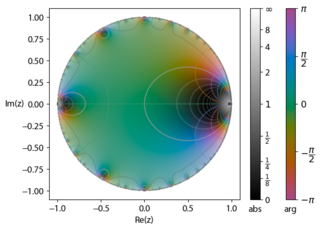In mathematics, the Euler function is given by

This article includes a list of references, related reading, or external links, but its sources remain unclear because it lacks inline citations. (July 2018) |
Named after Leonhard Euler, it is a model example of a q-series and provides the prototypical example of a relation between combinatorics and complex analysis.
Properties
The coefficient in the formal power series expansion for gives the number of partitions of k. That is,
where is the partition function.
The Euler identity, also known as the Pentagonal number theorem, is
is a pentagonal number.
The Euler function is related to the Dedekind eta function as
The Euler function may be expressed as a q-Pochhammer symbol:
The logarithm of the Euler function is the sum of the logarithms in the product expression, each of which may be expanded about q = 0, yielding
which is a Lambert series with coefficients -1/n. The logarithm of the Euler function may therefore be expressed as
where -[1/1, 3/2, 4/3, 7/4, 6/5, 12/6, 8/7, 15/8, 13/9, 18/10, ...] (see OEIS A000203)
On account of the identity , where is the sum-of-divisors function, this may also be written as
- .
Also if and , then[1]
Special values
The next identities come from Ramanujan's Notebooks:[2]
Using the Pentagonal number theorem, exchanging sum and integral, and then invoking complex-analytic methods, one derives[3]
References
Wikiwand in your browser!
Seamless Wikipedia browsing. On steroids.
Every time you click a link to Wikipedia, Wiktionary or Wikiquote in your browser's search results, it will show the modern Wikiwand interface.
Wikiwand extension is a five stars, simple, with minimum permission required to keep your browsing private, safe and transparent.























